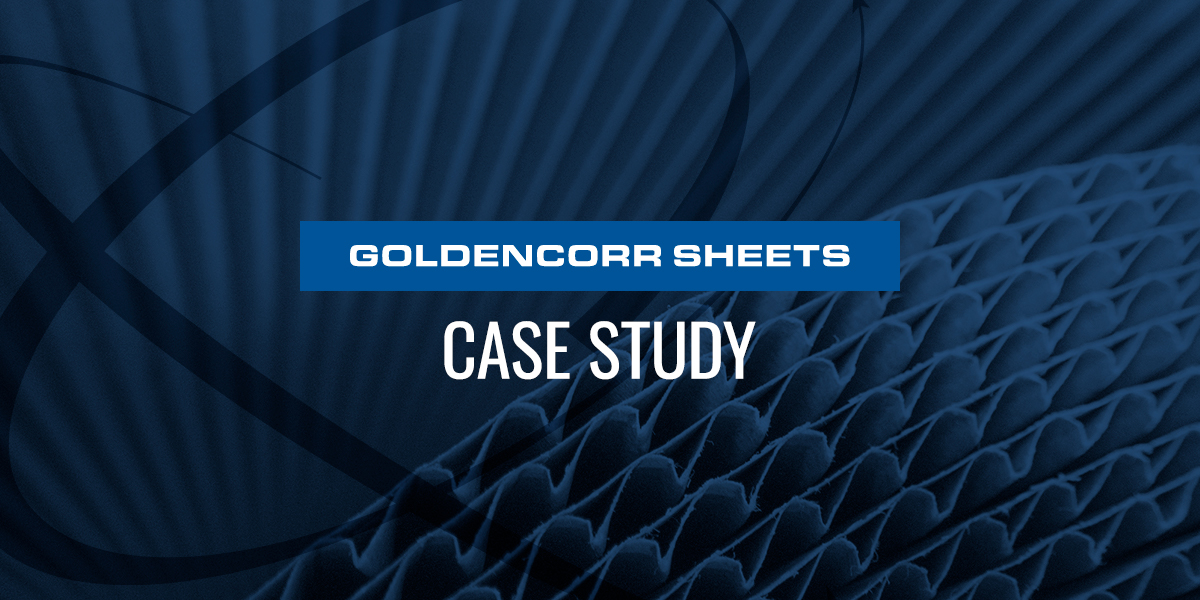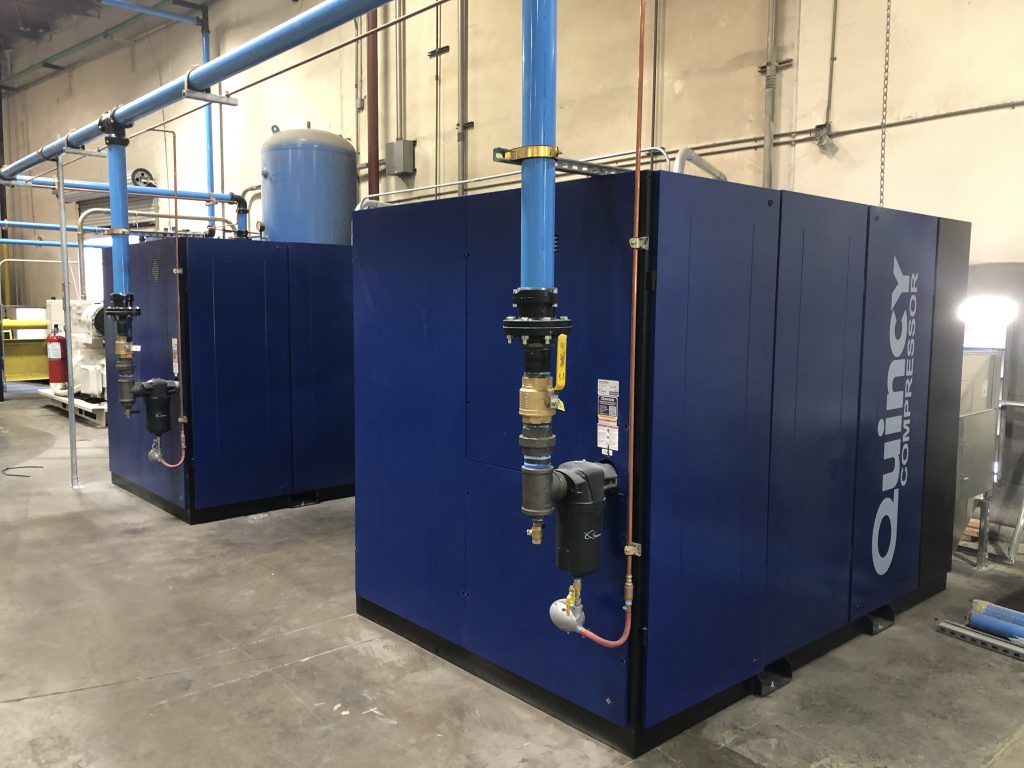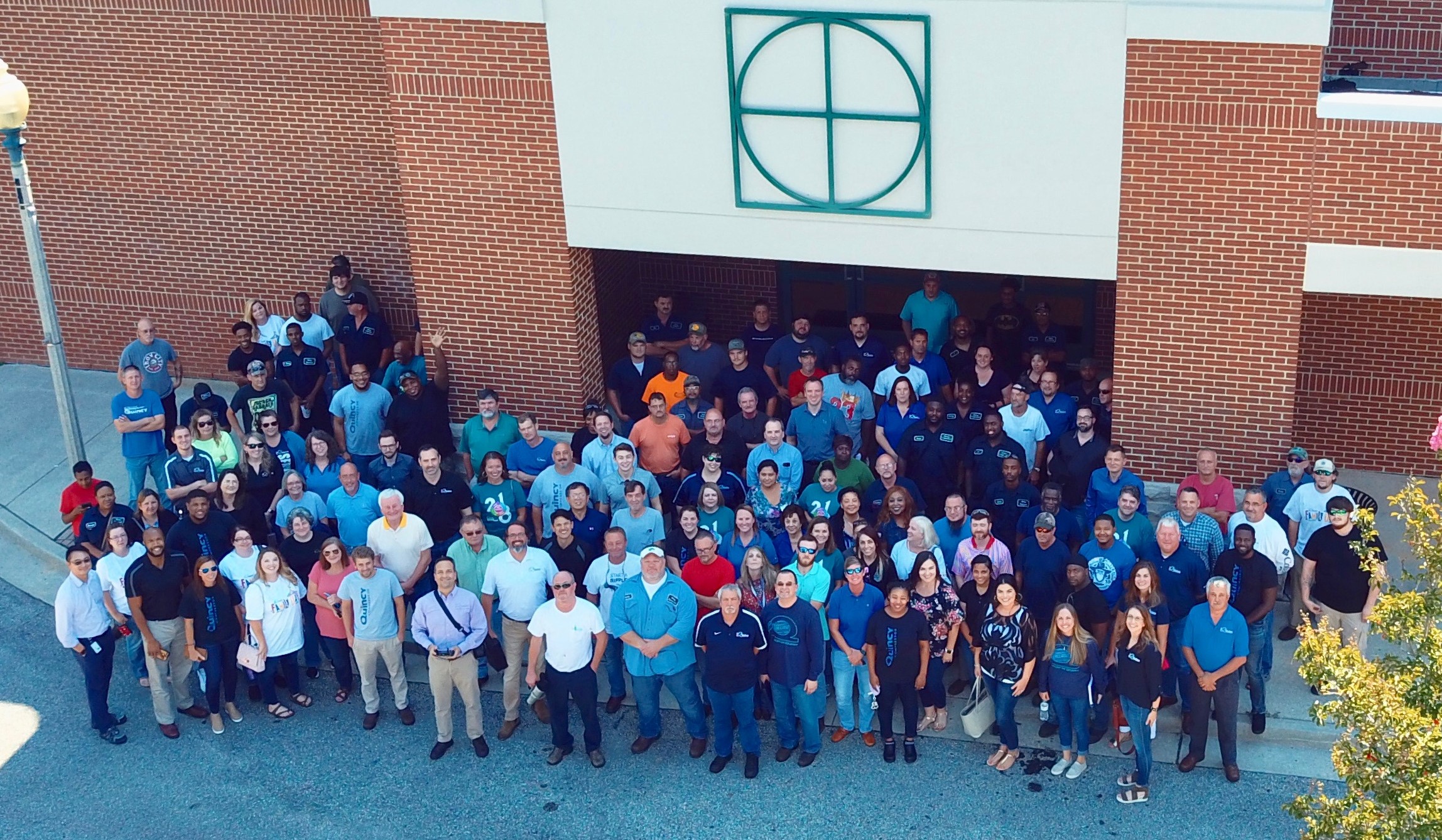
GoldenCorr Sheets is Southern California’s premier provider of corrugated sheets to the converting industry. GoldenCorr is in the heart of the Los Angeles County, City of Industry, California, and has been operating for over 20 years. In those 20 years, GoldenCorr has become one of the largest sheet feeder operations in North America.
GoldenCorr had three 200-horsepower(HP) competitor air compressors. Two of the compressors were from 2002, and the other was more recent, from 2019. GoldenCorr had spent lots of money on repairs over the last 20 years and did not want to keep throwing money on repairs on compressors that were on their last leg. It was time to replace two of the compressors and find solutions to some of their inefficiencies.
The Challenge
Prior to the Quincy EQ air rating study, GoldenCorr had several pain points with their air compressors. These challenges included:
- Low pressure alarms: GoldenCorr had air pressure drop issues at the end of their air lines. The machine at the end of this line would alarm if the pressure fell below 98 PSIG.
- Inefficient after-coolers: Because they are a paper plant, GoldenCorr had issues with tiny paper fibers clogging up the after-coolers. These fibers are a natural byproduct of production but caused high-temperature shutdowns that halted operations. With paper fibers going into the air-end of the air compressors, they were causing damage.
- GoldenCorr was also running two 200-horsepower non-VFD compressors. Even though the compressors ran in modulation, there was still a lot of room for improvement.
The Action Plan
To earn this job, Quincy Compressor needed to excel over five other air compressor competitors.
The main competitor was able to do an air study prior to Quincy Compressor’s study. Their recommended solution was a 200-HP VFD compressor and two 150-HP Load/Unload compressors.
Quincy Compressor wanted to see if there was another solution that solved the pain points and allowed the customer to save more operating costs. A local EQ-trained distributor arrived to conduct an air study. GoldenCorr mentioned that they had removed an air pump from their system process and planned to remove a second pump. This was all done after the initial air study by the competitor. In essence, these actions voided the air study.
The Quincy Compressor distributor mentioned to GoldenCorr that they may be able to go down in horsepower usage. The distributor explained that if they did another study after GoldenCorr took the second pump offline, they could see their true horsepower demand moving forward.
Quincy EQ Analysis
The distributor conducted an air study by installing EQ data loggers before and after GoldenCorr removed the second pump:
- They were able to collect critical information about system performance.
- The data collected from the EQ Logging Equipment analyzing the site information was uploaded to the EQ website.
- The EQ website’s patent-pending technology measured the existing system’s performance and modeled several potential system configurations to find the most effective solution.
This air study yielded an action plan for GoldenCorr to reduce horsepower. The data found that the GoldenCorr plant could run on a QSI-150 as the base-load air compressor. The plant could then use a QGV-150 as a trim compressor. This solution would take 100-HP offline, providing GoldenCorr with significant energy and cost savings.
The distributor tailored the solution to GoldenCorr’s needs by asking questions about their future needs and finding out that the customer would be lowering their air demand. The distributor spoke to GoldenCorr about air usage and discovered that the more air demand that can be taken offline, the smaller the horsepower of the air compressors needed to run the GoldenCorr facility. By asking these questions and understanding the customer’s needs, the distributor became the trusted consultant among the competitors.
Quincy EQ Results
Before the Quincy EQ air study with the second pump removed, GoldenCorr’s data revealed that:
- The plant’s kW usage was between 310 kW and 390 kW.
- The plant air pressure was not steady and jumped between 87 PSIG and 107 PSIG.
- When the air pressure dropped below 98 PSIG, the last machine alarmed.
After the air study, which was done after the second air pump was taken offline:
- The kW usage dropped to between 160 kW and 270 kW, a much more acceptable level for the customer.
- GoldenCorr’s kW savings were between 150 kW and 210 kW.
- The plant pressure remained steady between 98 PSIG and 112 PSIG.
- The steady pressure removed the fear that the alarm at the end of the air line would go off, reducing the chances of an emergency system shutdown.
“I tailored the solution to the customer’s needs by asking questions about the customer’s future needs and finding out that the customer would be lowering his air demand. I spoke to the customer about air usage; the more air demand he is taking offline, the smaller the horsepower of the compressors needed to run his facility. By doing this, I became the trusted consultant.” – Francisco Casique, Quincy Sales Engineer
The Quincy Solution
To address all of GoldenCorr’s pain points, the Quincy Compressor distributor had to engineer a unique system. This air compressor system needed to resolve the clogged after-cooler issue and eliminate high-temperature system shutdowns. A solution to these issues demanded a whole-system approach. The distributor’s solution included two primary stages:
- Eliminating the paper fiber clogging issue: To remove the issue of paper fibers clogging the after-coolers and going into the air-end, the distributor had a contractor install air vents to feed the outside air to the air compressor’s inlet. These air vents work by keeping the after-cooler free of paper fibers, dust and other debris to keep temperatures at the proper level efficiently. The contractor also installed package pre-filters on each air compressor for additional efficacy at filtering obstructions.
- Lowering the room’s temperature: Also, to remove the excess heat from the room, the contractor installed a duct that exhausts through the roof. This exhaust, along with the air vents, removes the possibility of hot air being recycled. Lowering the temperature within the compressor room reduced the chances of the compressor going down due to overheating.
Together, these solutions prevent slow-downs and inefficiencies in the after-coolers and air compressors.
The distributor also recommended that GoldenCorr order replacement equipment, like new air compressors. Due to the lower air demand from removing the pumps from the system processes, using more efficient equipment will further help GoldenCorr reduce operating costs.
About Quincy Compressor
Quincy Compressor specializes in compressed air technology, offering top-notch products and services since 1920. Serving the industry for over 100 years, Quincy is on the cutting edge, engineering quality and reliability into every offering. Award-winning accomplishments have allowed Quincy to build solid relationships with its customers and achieve compressed air systems best practices. Quincy’s flagship products include the QSI and QGV rotary screw compressors, the reciprocating QR-25, QT and Climate Control packages along with its innovative Royal Blue Warranty, widely recognized as among the industry’s strongest warranty program.




